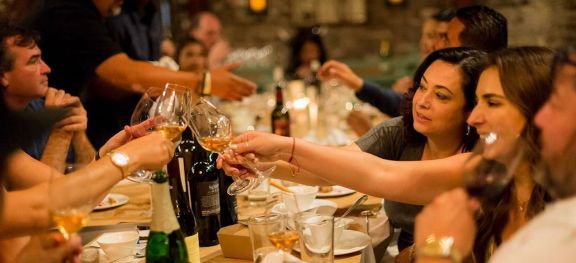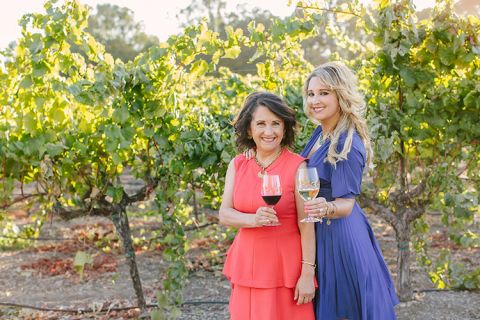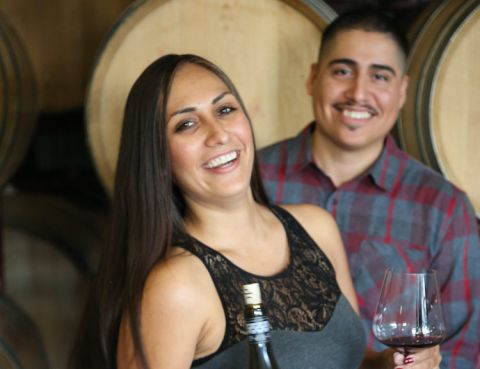California’s Latino-owned wineries mushroom

2 December 2020 With a few additions today, 52 Latino-owned California wineries are now listed at the end of this article.
26 November 2020 We're delighted to publish this important article free this Thanksgiving Day.
23 November 2020 California vineyard workers are increasingly becoming winery owners in a story charted here by Alder, who also provides us with as comprehensive a list as he can muster. Above, the Mexican American Vintners Association's 2018 winemaker dinner. All images courtesy of their subjects.
The first people to make wine in California were almost certainly Mexicans. In the latter half of the 18th century, Franciscan missionaries explored north from Mexico into the area known then as Alta California, establishing a chain of missions up America’s west coast. These men, a mix of Spanish missionaries and their indigenous Mexican converts and labourers, brought vine cuttings to plant at these frontier outposts. By the early 1800s, sacramental wine made from Listan Prieto, known at that time simply as the Mission grape, was produced successfully at several established missions along the California coast.
More than 200 years later, Mexican-American wineries are having something of a renaissance, as pioneering Latinos and their children, many of whom have spent their entire lives working in the California wine industry, establish their own wine projects.
California’s modern wine industry has always owed a huge debt to the Latino community, of course, as has much of the state’s agriculture in general. Since the repeal of Prohibition in 1939 the vast majority of vineyard labour in California has been performed by Mexican-Americans and other immigrants from various countries in Central America.
In the earliest days, this labour force was heavily migrant, made up of families who would travel to follow the transition of one crop to the next, making wine country one of their many stops on a gruelling annual tour of California harvests.
But as the California wine industry began to get its footing again in the 1970s, it became clear to growers that they required skilled rather than unskilled labour, driving demand for experienced vineyard hands who could work in the vineyards year-round.
More porous borders and less inflammatory politics surrounding immigration allowed a whole generation of Latinos to follow their quest for a piece of the American dream, building resident communities in and around California wine country.
‘My father applied for a green card in Mexico City, and we had one six weeks later’, remembers Amelia Ceja, president of Ceja Vineyards in Napa. ‘I had never left my village before the time I went to pick up my passport and made the trip to Napa in September of 1967.’ (See Jancis's report on a visit to northern California back in 2002 for the first mention of Ceja on this site.)
Ceja arrived at the age of 12, unable to speak a word of English, and immediately went to work with her father in the vineyards where, as it happened, he was harvesting Merlot in Mondavi’s To Kalon vineyard.
‘It was my first week in America, and I spent the first hour of each day eating grapes before I got around to picking them’, says Ceja. ‘At the end of the week, I was paid $3.50, and when I was handed the money, I turned to my father and said, “I love grapes. One day I’m going to have a vineyard of my own.”’
Those would turn out to be prophetic words. The Ceja family would go on to be among some of the first Latino winegrowers in the Carneros region of Napa and Sonoma when, after saving for decades, the family purchased their first 15 acres (6 ha) in 1983. By 1998 the family owned and was farming more than 150 acres of vineyards in Napa and Sonoma, and finally felt ready financially to begin production of their own wine.
The Ceja family’s journey to becoming winery owners both literally and figuratively offers something of a blueprint that a number of other families followed, in what might be considered the first wave of Latino winery ownership in the early 1990s; an entire generation of hard work and savings yielding the opportunity to own land, farm it, and eventually make wine from it.
But that is not the only path that Latino wine producers have followed in California.
Rolando Herrera came to America first as a young boy with his father in 1975, spending five of his grade-school years in Napa before returning to Mexico in 1980. By the time he was ready to go to high school, he had decided Napa was where he wanted to make a life for himself, and convinced his parents to let him return, a simple proposition thanks to his father’s residency permit.
However, with the recklessness that only a 15-year-old boy could muster and the grudging permission of his parents, Herrera decided he wanted to cross the border illegally.
‘I wanted to live all those stories that my uncles and relatives would tell me about’, laughs Herrera. ‘I wanted to run and hide and jump and make it on my own. Back then it wasn’t as difficult, but it still was pretty dangerous. I remember family members arriving home beaten and bruised all the time.’
Herrera crossed without incident, arriving back in Napa in 1983.
Herrera and his 17-year-old brother lived together with 15 other Mexican workers in a tiny apartment on Lincoln Avenue in Napa. During the day he would go to high school, and at night he would work at his job in the kitchen at the luxurious Auberge du Soleil resort as a dish-washer and prep cook.
‘I didn’t really care for cooking, so in 1985 I decided to take a job for a few weeks and try out working in the vineyards’, recalls Herrera. There wasn’t a lot of work to be done at the time, but the foreman of the vineyard crew was also building a garden wall for a client, and one day asked Herrera if he’d come along to help out.
A few days into the job the client stopped Herrera, impressed by his work ethic, and struck up a conversation. By the end of that conversation that client, Warren Winiarski, had offered Herrera a job in his cellar. A mere three years later, Winiarski would promote Herrera to be cellarmaster at Stag’s Leap Wine Cellars, a position he held until he realised his true career aspirations lay in making wine, rather than simply managing the process.
Herrera soon landed a position as assistant winemaker at Chateau Potelle winery and spent three years soaking up as much knowledge as he could about every aspect of winemaking and winegrowing. But then in 1996 when he was ready to get his first job as lead winemaker, no one would return his calls.
‘Sure, I had three years as an assistant winemaker, and 13 years of experience’, says Herrera, who had even completed 90% of his associate’s degree in winemaking. ‘But at that point I was competing with people who had oenology degrees from Davis or Fresno or even from Europe. No one was willing to interview me.’
After discussing it with his wife, having married only a few months earlier, Herrera took a gamble. He figured that while he might not have a degree, he could use a wine he had made as credentials. So the two pooled their meagre savings, filed the paperwork to make their garage a legal winery, and bought some Chardonnay grapes.
‘I thought, “I’ll bottle a few cases and use that instead of a diploma”’, says Herrera. ‘I figured I’d sell the rest on the bulk market to help pay for the barrels.’
In the spring of 1998, when he finally let his friends taste the wine, they all told him it was far too good to sell in bulk. So Herrera took a deep breath and created his own wine label, which he and his wife Lorena decided should be called Mi Sueño or My Dream. The wine quickly sold out, and continued to do so for several years, in addition to providing exactly the kind of calling card Herrera needed to land the winemaker job, first at Vine Cliff winery and later as director of winemaking for Paul Hobbs.
The Herreras and the Cejas, along with other wineries such as Madrigal Family Vineyards and Gustavo Thrace, were pioneers of two familiar archetypes for Latino-owned wineries, with stories that are instantly recognisable to anyone familiar with the ethos that motivates so many immigrant journeys to success.
‘We have a saying in Mexico, “trabajo como un burro” [work like a donkey]’, says Ceja. ‘We do the work no matter what it takes. That’s what our parents did for us, and that’s what we’re doing for our children.’
But other Latinos have taken different paths to winery ownership. One of the first Latino-owned wineries in Napa was started by Manny Frias, who moved with his family from Jalisco, Mexico, to San Francisco in the 1950s.
Manny grew up in San Francisco, went to college and graduate school, earning several graduate degrees, and fell in love with wine along the way, frequently visiting Napa to taste with friends. Eventually he decided he wanted to do more than just visit wine country. In 1977, Frias purchased 100 acres (40 ha) on Napa’s Spring Mountain and began taking viticulture and oenology classes at Napa Valley College. Ten years later, he released the first vintage of FRIAS Family Vineyard, which is now run by his two sons Manny Jr and Fernando.
After the initial pioneers in the early 1990s, the growth of Latino-owned wineries was slow, but in the past 10 years the pace has accelerated across all California wine regions.
‘There’s definitely a surge in Mexican-American or Latino wineries’, says Guillermo Herrera, President of the Mexican American Vintners Association, which was founded in 2010 by Rolando Herrera (no relation), Amelia Ceja and the Robledo Family of winegrowers. ‘It used to be we would add one or two members per year, but lately there has been a lot more interest.’
Herrera says there’s no single cause to which he can attribute the increase in his membership. ‘No one thing, except generally people achieving some level of prosperity thanks to success in their particular realm due to hard work and perseverance. There’s a strong tradition of contribution to family and legacy in our culture.’
By my count there are now more than 45 Latino-owned wineries in California, though I’m sure I have missed some that might be similar to Top Winery in Paso Robles, which was started in 2013 by two young entrepreneurs looking to make a career change and follow their passion for wine. Elena Martinez, a foreclosure banker, and Stanley Barrios, a facilities and building manager, are high-school sweethearts who started drinking wine together in their early twenties. Both grew up as children of Central American immigrants in Los Angeles, but with no ties to the wine industry other than their mutually discovered appreciation for drinking it. Their story isn’t any different from the hundreds of new wine brands that have sprung up throughout California in recent years.
Martinez and Barrios, both still in their early 30s, are hoping to be part of a generation in the wine business for whom the fact that they are both Latinos seems unworthy of comment. Such a future seems possible, but there’s still a long road ahead.
‘If I don’t think about how I am dressed when I visit my consulting clients, I am sometimes mistaken for a vineyard worker and directed around back to the “production side”’, says Martin Reyes, the first Mexican-American to hold the title of Master of Wine [and joint winner of our 2020 writing competition – JR]. Reyes is also the founder of WineUnify, an organisation dedicated to championing diversity and inclusion for under-represented minorities in the US wine industry.
We’ve come a long way from the first pioneers of winegrowing in California, suggests Reyes, but there’s still work to do in highlighting the skills, knowledge and achievements of people who have long been the invisible engine behind the California wine industry.
‘The line of history arcs way back, in a way that shatters preconceptions and turns the narrative of the Mexican winemaker on its head’, says Reyes. ‘The firsts of anything are elusive as borders and people move, and there is inexorable movement upward from labour to ownership. We’ve always been there, but now people are finally paying attention.’
I could find no comprehensive list of Latino-owned wineries in California (in fact, the longest list I found had a mere 18 entries) so I have made my best efforts to create one, with apologies in advance to any producer I may have missed.
Napa
Bazán Cellars
Ceja Vineyards
Cervantes Family Vineyards
Frias Family Vineyard
Gustavo Wine
Herencia Del Valle
Honrama Cellars
Justicia Wines
Llamas Family Wines
Madrigal Family Winery
Maldonado Vineyards
Mi Sueño Winery
Palmaz Vineyards
Piña Napa Valley
Rios Wine Company
Robledo Family Winery
Scalon Cellars
Alex Sotelo Cellars
Tres Perlas
Viader
Voces Cellars
Sonoma
Aldina Vineyards
Cattleya Wines
Chavez Family Cellars
Delgadillo Cellars
Encanto Vineyards
Enriquez Estate Wines
Fathia Wines
Guerrero Fernandez Winery
Keller Estate
Reynoso Family Vineyards
Valdez Family Winery
Mendocino
Monterey
Sierra Foothills
Bodega del Sur
Borjón Winery
E16 Winery
Jose Wine Caves
Miraflores
Purity Wine
Villa Vallecito Vineyards
Lodi
Central Coast/Paso Robles
Bodega de Edgar
Lepe Cellars
Top Winery
Santa Barbara
Camins2Dreams
Esfuerzo Wines
Feliz Noche Cellars
Runway Vineyards
Los Angeles
Become a member to view this article and thousands more!
- 15,415 featured articles
- 274,225 wine reviews
- Maps from The World Atlas of Wine, 8th edition (RRP £50)
- The Oxford Companion to Wine, 5th edition (RRP £50)
- Members’ forum
- 15,415 featured articles
- 274,225 wine reviews
- Maps from The World Atlas of Wine, 8th edition (RRP £50)
- The Oxford Companion to Wine, 5th edition (RRP £50)
- Members’ forum
- Commercial use of our Tasting Notes



